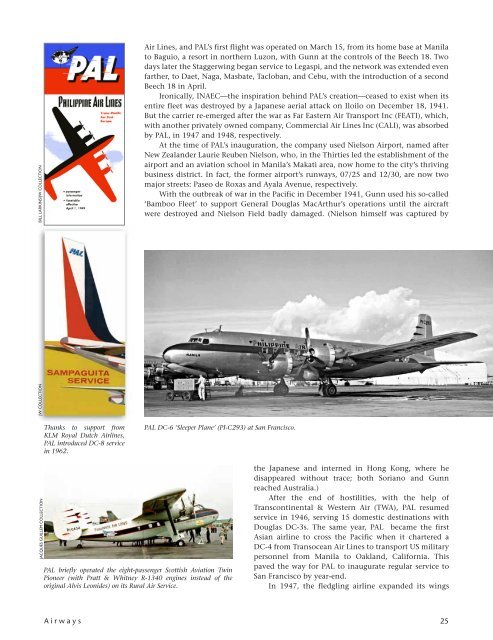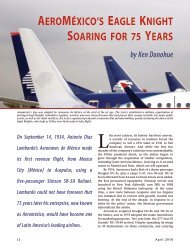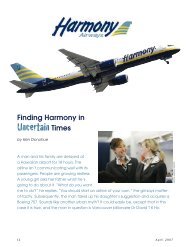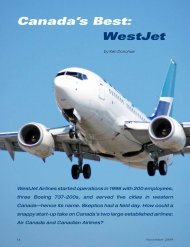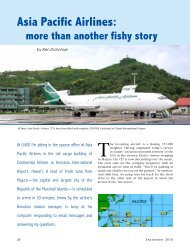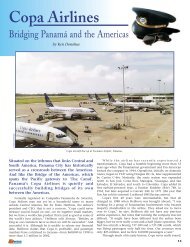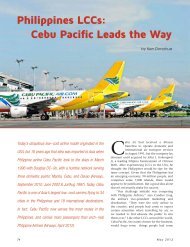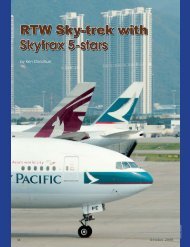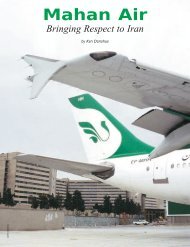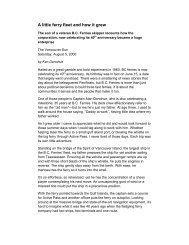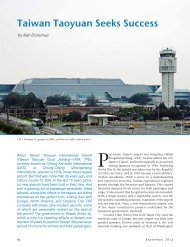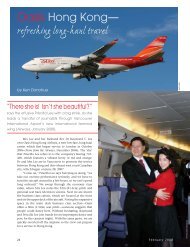Philippine Airlines: Asia's First, Striving to Shine - Ken Donohue
Philippine Airlines: Asia's First, Striving to Shine - Ken Donohue
Philippine Airlines: Asia's First, Striving to Shine - Ken Donohue
Create successful ePaper yourself
Turn your PDF publications into a flip-book with our unique Google optimized e-Paper software.
BILL LARKINS/JW COLLECTION<br />
Air Lines, and PAL’s first flight was operated on March 15, from its home base at Manila<br />
<strong>to</strong> Baguio, a resort in northern Luzon, with Gunn at the controls of the Beech 18. Two<br />
days later the Staggerwing began service <strong>to</strong> Legaspi, and the network was extended even<br />
farther, <strong>to</strong> Daet, Naga, Masbate, Tacloban, and Cebu, with the introduction of a second<br />
Beech 18 in April.<br />
Ironically, INAEC—the inspiration behind PAL’s creation—ceased <strong>to</strong> exist when its<br />
entire fleet was destroyed by a Japanese aerial attack on Iloilo on December 18, 1941.<br />
But the carrier re-emerged after the war as Far Eastern Air Transport Inc (FEATI), which,<br />
with another privately owned company, Commercial Air Lines Inc (CALI), was absorbed<br />
by PAL, in 1947 and 1948, respectively.<br />
At the time of PAL’s inauguration, the company used Nielson Airport, named after<br />
New Zealander Laurie Reuben Nielson, who, in the Thirties led the establishment of the<br />
airport and an aviation school in Manila’s Makati area, now home <strong>to</strong> the city’s thriving<br />
business district. In fact, the former airport’s runways, 07/25 and 12/30, are now two<br />
major streets: Paseo de Roxas and Ayala Avenue, respectively.<br />
With the outbreak of war in the Pacific in December 1941, Gunn used his so-called<br />
‘Bamboo Fleet’ <strong>to</strong> support General Douglas MacArthur’s operations until the aircraft<br />
were destroyed and Nielson Field badly damaged. (Nielson himself was captured by<br />
JW COLLECTION<br />
Thanks <strong>to</strong> support from<br />
KLM Royal Dutch <strong>Airlines</strong>,<br />
PAL introduced DC-8 service<br />
in 1962.<br />
PAL DC-6 ‘Sleeper Plane’ (PI-C293) at San Francisco.<br />
JACQUES GUILLEM COLLECTION<br />
PAL briefly operated the eight-passenger Scottish Aviation Twin<br />
Pioneer (with Pratt & Whitney R-1340 engines instead of the<br />
original Alvis Leonides) on its Rural Air Service.<br />
the Japanese and interned in Hong Kong, where he<br />
disappeared without trace; both Soriano and Gunn<br />
reached Australia.)<br />
After the end of hostilities, with the help of<br />
Transcontinental & Western Air (TWA), PAL resumed<br />
service in 1946, serving 15 domestic destinations with<br />
Douglas DC-3s. The same year, PAL became the first<br />
Asian airline <strong>to</strong> cross the Pacific when it chartered a<br />
DC-4 from Transocean Air Lines <strong>to</strong> transport US military<br />
personnel from Manila <strong>to</strong> Oakland, California. This<br />
paved the way for PAL <strong>to</strong> inaugurate regular service <strong>to</strong><br />
San Francisco by year-end.<br />
In 1947, the fledgling airline expanded its wings<br />
A i r w a y s<br />
25


